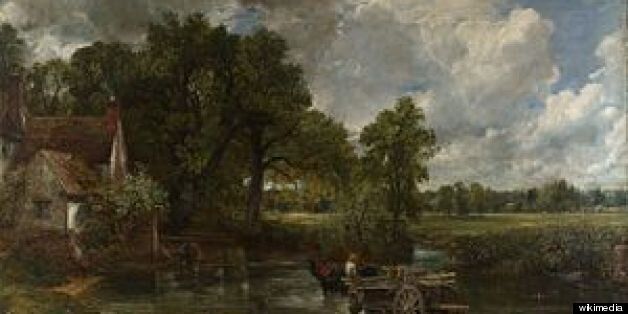
A world-famous painting on public display in the National Gallery in London is attacked, vandalised, as an act of political protest. Almost 100 years ago, the first attack that fit that description took place. This week it happened again when Fathers4Justice stuck a picture of a boy onto Constable's masterpiece, The Hay Wain.
Back in 1914, Mary Richardson committed probably the most famous attack ever on a piece of art when she took a meat cleaver to Velázquez's Rokeby Venus. As a suffragette, she claimed her attack in the National Gallery was provoked by the jailing of Emmeline Pankhurst.
Though Pankhurst, the leader of the militant suffragette movement, had been arrested the day before, the idea to vandalise art had been discussed for some time by the suffragettes. Pankhurst's arrest therefore may have been as much an opportunity as well as a motive for Richardson's attack.
Emmeline Pankhurst and her suffragettes are credited for establishing art vandalism as a form of political protest. Its impact as a public spectacle and headline-grabbing newsworthy event designed specifically to generate press coverage for the cause was very successful. The attack on Constable's masterpiece today was an attempt to follow that template.
And there have been many other such incidents.
The statue of The Little Mermaid in Copenhagen harbour was decapitated by members of the Situationist Movement in 1964 as a protest against capitalism. The world's most famous painting, Mona Lisa, was attacked in 1974 with spray paint when it was on tour in Tokyo by a handicapped woman protesting at disabled access to the gallery. (Notably the Mona Lisa has not left Paris since.)
A statue of Margaret Thatcher was decapitated at the Guildhall Art Gallery in 2002. The attack was committed by Paul Kelleher who said at his trial that this was his "artistic expression and my right to interact with this broken world." It speaks volumes of how seriously his motivations were taken that the jury at his first trial were unable to decide whether Thatcher's policies were enough of an excuse. It took a second trial and a second jury to eventually convict Kelleher of criminal damage.
Political protest through art vandalism casts a wider net than just a direct attack on original pieces of work.
The cover to The Sex Pistols song God Save the Queen was a defaced copy of the Cecil Beaton photograph of the Queen. It's an iconic image of protest that will be forever associated with the punk movement but it was incredibly controversial at the time.
An instinctive reaction is to be outraged when we hear of works of art being attacked. Why? Art's great power is in its irreverence. Why should we therefore be reverent of it?
Let's not forget that art itself can be a political expression. Picasso's Guernica, Manet's The Execution of Maximilian, Malevich's The Black Square, the whole of Banksy's back catalogue... The list of politically charged works is long and illustrious. And the legacy of these political works is potent.
A tapestry of Picasso's Guernica hangs in the lobby to the United Nations as a constant reminder of the destructive impact of war. Such is its emotive impact that when then-Secretary of State Colin Powell made his case for the war against Iraq there in 2003, the US delegation insisted the artwork was covered up. Sadly the UN agreed.
If we are to embrace art as freedom of expression, isn't it hypocritical of us to deny freedom of expression to those who use art as part of their protest? Where are the limits of expression?
Artists themselves have been challenging these limits when faced with works of art completed by others.
Rauschenberg famously erased a de Kooning drawing as an investigation into the limits of artistic expression. This was also the reason given by the Chapman brothers, Jake and Dinos, when they bought a series of rare Goya prints "and changed all the visible victims' heads to clowns' heads and puppies' heads."
Vladimir Umanets was sentenced to two years imprisonment for criminal damage when he took black paint to a Rothko in the Tate Modern as an artistic act. He later said, "Art allows us to take what someone's done and put a new message on it." This is a very interesting argument.
It's always going to be a fine balancing act between allowing the public to view art yet protecting it from damage. And given the well-established pattern of attacking publicly displayed art as a quick and easy way to get headlines, curators will remain concerned.
But art demands reaction. It insists it speaks, represents and reflects society. It refuses to be obedient and respectful. It thrives on its commentary and its controversy. Inspiring debate and providing insight is the purpose of art, of culture. So we must therefore embrace all the responses to art, no matter what form that response takes.
The attack on Constable's The Hay Wain by Fathers4Justice is just the latest in a long line of political protests, using the vandalism of art to gain headlines. I doubt it will be the last, and we should welcome that. As much as art reflects the society of that time, so do the attacks on it.